Market Overview
The global smart agriculture market is projected to reach USD 29.1 billion in 2025 and is expected to grow to USD 97.2 billion by 2034, registering a CAGR of 14.3%. Growth is driven by the rising adoption of precision farming, IoT-enabled farm management, smart irrigation systems, and automation technologies that enhance crop productivity, optimize resource use, and support sustainable agricultural practices globally.
Smart agriculture refers to the application of modern digital tools and automated solutions to farming that improve crop and livestock productivity while promoting sustainability. It leverages technologies like GPS-based equipment, predictive analytics, drone surveillance, cloud computing, blockchain, and remote sensing to enable farmers to make data-backed decisions. By reducing dependency on manual processes and growing operational precision, smart agriculture ensures higher efficiency, better resource utilization, reduced environmental footprint, and resilience against unpredictable weather and pest infestations. This approach not only boosts profitability for farmers but also strengthens the global food supply chain.
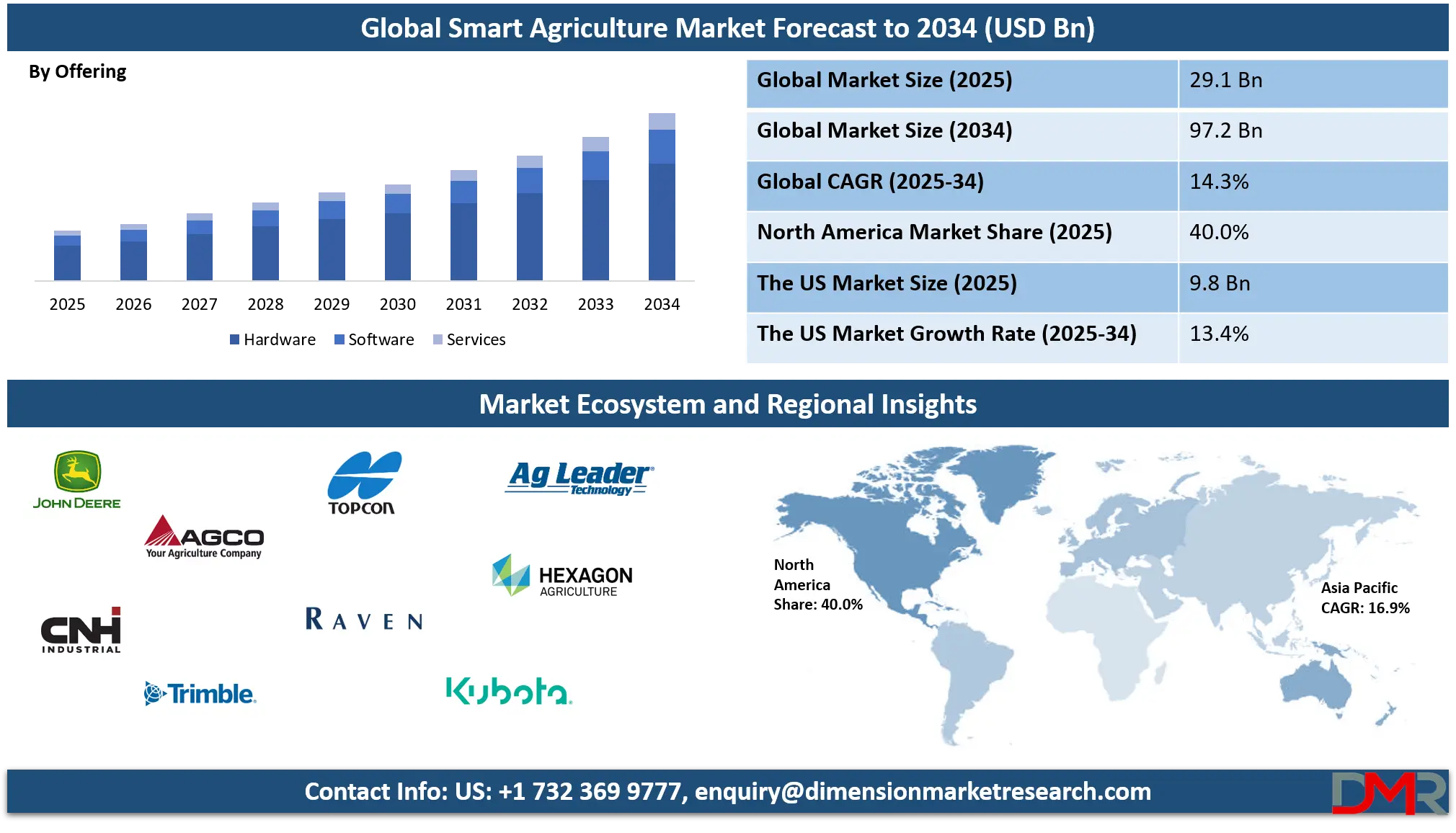
The global smart agriculture market is an evolving ecosystem that integrates precision farming, climate-smart solutions, digital livestock management, and automated equipment into a unified agricultural framework. Rising food demand due to population growth and limited availability of cultivable land are pushing stakeholders to adopt advanced solutions. Adoption of technologies such as AI-powered farm management platforms, soil health monitoring systems, and automated irrigation ensures better crop quality and higher yields with reduced input costs. Countries across North America, Europe, Asia Pacific, and the Middle East are increasingly investing in smart farming solutions to address regional food security challenges.
With the growing role of sustainability and resource optimization, the smart agriculture market has become central to global agribusiness strategies. Investments in robotics, autonomous tractors, and integrated IoT platforms are accelerating innovation and scaling adoption even in emerging economies. Governments and private organizations are also collaborating to provide subsidies, digital literacy programs, and infrastructure for rural farmers to access modern agricultural technologies. As the need for traceability, efficiency, and climate-resilient practices rises, the global smart agriculture market is expected to transform farming into a more intelligent, connected, and sustainable industry in the coming years.
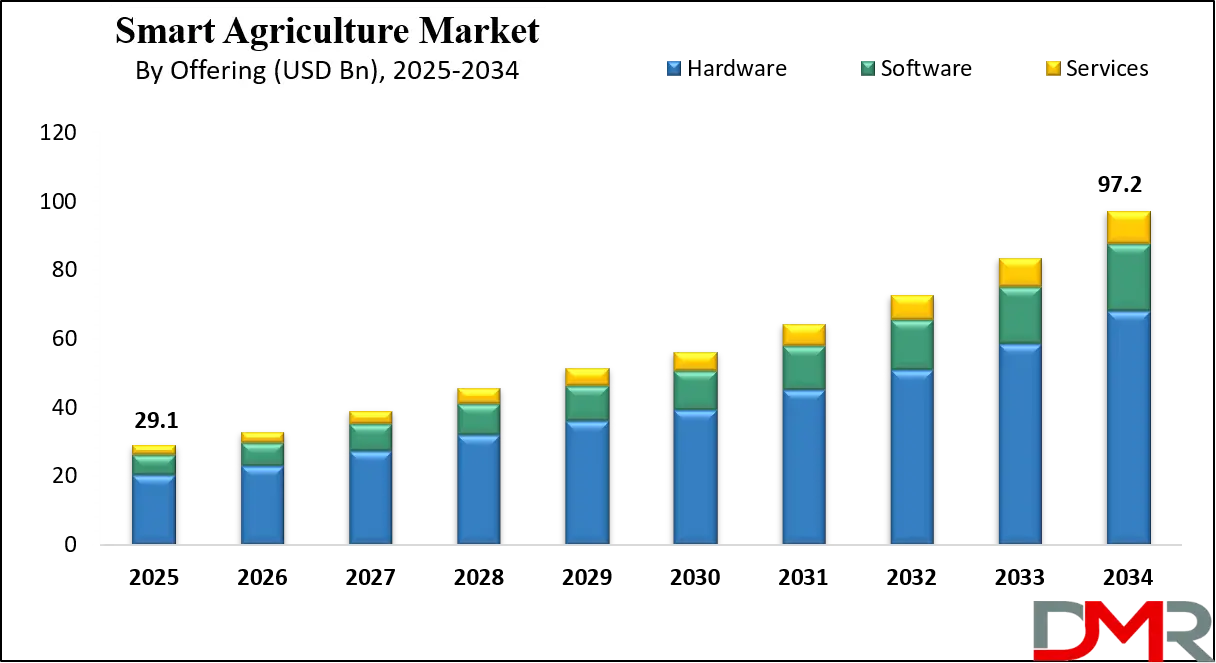
The US Smart Agriculture Market
The US Smart Agriculture Market is projected to be valued at USD 9.8 billion in 2025. It is expected to witness subsequent growth in the upcoming period as it holds USD 30.4 billion in 2034 at a CAGR of 13.4%.
The US smart agriculture market is experiencing significant growth as farmers increasingly adopt advanced technologies to address labor shortages, rising input costs, and the demand for sustainable farming practices. Precision agriculture solutions, including drone surveillance, satellite imagery, and GPS-enabled machinery, are widely used to optimize seeding, fertilization, and irrigation. The integration of IoT devices, real-time monitoring systems, and predictive analytics is helping farmers enhance crop yields while conserving water and energy resources. Growing investments in agri-tech startups and strong government support for digital farming initiatives are further accelerating the adoption of smart farming solutions across the country.
In addition, the US smart agriculture market is being shaped by advancements in livestock monitoring, greenhouse automation, and AI-powered farm management software that streamline operations and improve food quality. Large-scale agribusinesses and mid-sized farms are increasingly leveraging robotics, autonomous tractors, and blockchain-enabled supply chain systems to ensure traceability and efficiency. The country’s focus on climate-smart agriculture and data-driven farming practices is positioning it as a leader in agricultural innovation. With expanding rural connectivity and adoption of 5G technology, the US market is set to transform farming into a highly automated, sustainable, and resilient sector in the years ahead.
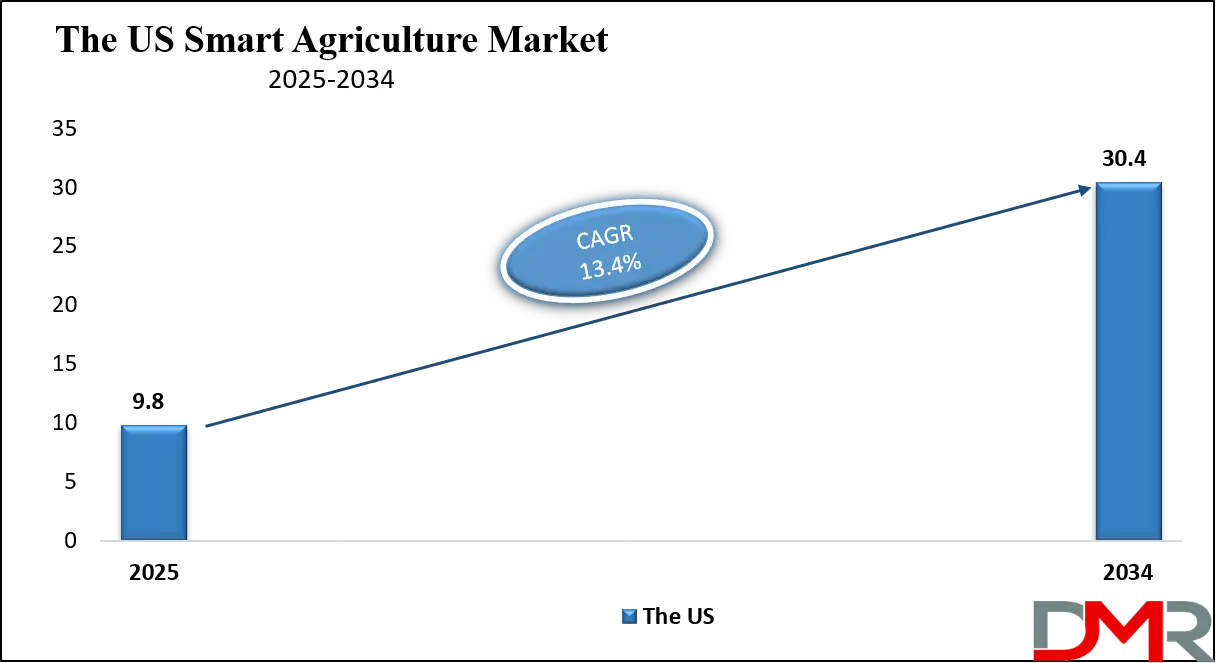
Europe Smart Agriculture Market
The Europe smart agriculture market is projected to reach USD 5.8 billion in 2025, reflecting the region’s strong focus on precision farming, sustainable agriculture, and technological modernization. Farmers across countries such as Germany, France, and the Netherlands are increasingly adopting IoT-enabled sensors, GPS-guided equipment, and AI-powered farm management systems to optimize crop yields, reduce input costs, and improve operational efficiency.
Government initiatives promoting digital agriculture, precision irrigation, and climate-resilient farming practices are further supporting the expansion of the market. Additionally, growing awareness of environmental sustainability and the need to address labor shortages are accelerating the adoption of automation and smart solutions in European agriculture.
Europe’s smart agriculture market is expected to maintain a robust CAGR of 13.1% over the forecast period, driven by continuous innovations in agri-tech and growing investments from both private and public sectors. Key segments such as smart irrigation, livestock monitoring, and greenhouse automation are witnessing significant growth due to rising demand for high-value crops, efficient water usage, and controlled environment farming.
Moreover, collaborations between technology providers and agricultural cooperatives are facilitating the deployment of scalable solutions across the region. As precision agriculture becomes mainstream, Europe is poised to emerge as a critical hub for smart farming solutions in the global market.
Japan Smart Agriculture Market
The Japan smart agriculture market is estimated to reach USD 600 million in 2025, reflecting the country’s strong emphasis on modernizing its agricultural sector through technology-driven solutions. Japanese farmers are increasingly adopting precision farming techniques, including IoT-enabled sensors, drones, and AI-powered crop management platforms, to optimize yields, reduce labor dependency, and improve resource efficiency. Government initiatives promoting digital agriculture, sustainable practices, and smart irrigation systems are further driving the adoption of these technologies. Additionally, Japan’s focus on high-value crop production and controlled environment farming is boosting demand for greenhouse automation and robotics solutions.
The market in Japan is expected to grow at a robust CAGR of 14.6% over the forecast period, supported by continuous innovations in automation, AI, and data analytics for agriculture. Autonomous tractors, robotic harvesters, and real-time livestock monitoring systems are gaining traction among large-scale and smallholder farmers alike. Strategic collaborations between technology providers, research institutions, and agribusinesses are facilitating the deployment of integrated solutions across the country. With growing attention on labor shortages, sustainable practices, and high-quality food production, Japan is poised to become a significant contributor to the global smart agriculture market.
Global Smart Agriculture Market: Key Takeaways
- Market Value: The global Smart Agriculture market size is expected to reach a value of USD 97.2 billion by 2034 from a base value of USD 29.1 billion in 2025 at a CAGR of 14.3%.
- By Offering Segment Analysis: Hardware is anticipated to dominate the offering segment, capturing 70.0% of the total market share in 2025.
- By Agriculture Type Segment Analysis: Precision Farming will dominate the agriculture type segment, capturing 50.0% of the market share in 2025.
- By Application Segment Analysis: Yield Monitoring & Crop Management will dominate the application segment, capturing 22.0% of the market share in 2025.
- Regional Analysis: North America is anticipated to lead the global Smart Agriculture market landscape with 40.0% of total global market revenue in 2025.
- Key Players: Some key players in the global Smart Agriculture market include Deere & Company (John Deere), AGCO Corporation, CNH Industrial N.V., Trimble Inc., Topcon Positioning Systems, Raven Industries, AG Leader Technology, Hexagon Agriculture, Kubota Corporation, Yara International, and Others.
Global Smart Agriculture Market: Use Cases
- Precision Crop Monitoring and Management: Precision crop monitoring is one of the most prominent use cases in the global smart agriculture market. Farmers leverage drones, satellite imaging, and IoT-enabled sensors to track soil health, crop growth, pest infestations, and nutrient requirements in real time. This data-driven approach reduces input costs by optimizing fertilizer and pesticide usage, while ensuring higher crop yields and better resource efficiency. Advanced farm analytics platforms further enable predictive insights, helping farmers mitigate risks linked to weather variability and climate change.
- Smart Irrigation and Water Management: Water scarcity has made smart irrigation systems a critical application in modern farming. Automated irrigation solutions combined with soil moisture sensors and weather-based forecasting allow farmers to apply the right amount of water at the right time. This not only conserves water resources but also enhances crop productivity by preventing over- or under-irrigation. With growing adoption in arid regions and water-stressed economies, smart irrigation is becoming an essential component of sustainable agriculture practices globally.
- Livestock Monitoring and Dairy Automation: The global smart agriculture market also sees growing adoption of livestock monitoring technologies that use wearable devices, RFID tags, and automated feeding systems. These tools track animal health, behavior, reproduction cycles, and nutrition levels, enabling farmers to ensure higher productivity and early detection of diseases. In dairy farming, automation solutions like robotic milking systems and real-time herd management platforms are transforming operations, reducing labor dependency, and improving milk quality and yield efficiency.
- Greenhouse Automation and Controlled Environment Farming: Greenhouse automation is revolutionizing controlled environment agriculture by integrating climate control systems, automated lighting, and smart irrigation. These solutions allow year-round crop cultivation, optimize input usage, and enhance the quality of high-value crops such as vegetables, flowers, and fruits. By leveraging IoT sensors, AI-driven platforms, and robotics, greenhouse operators can maintain ideal growing conditions with minimal manual intervention. This use case is particularly impactful in urban farming and regions with limited arable land.
Impact of Artificial Intelligence on the global Smart Agriculture market
Artificial intelligence is playing a transformative role in the global smart agriculture market by enabling data-driven decision-making and automation across the entire agricultural value chain. AI-powered platforms analyze massive datasets from IoT devices, sensors, drones, and satellite imagery to provide actionable insights on soil conditions, crop health, irrigation needs, and pest outbreaks. This predictive capability allows farmers to optimize resource allocation, reduce input costs, and maximize yields while minimizing environmental impact. AI also supports real-time monitoring of field operations, empowering growers to respond quickly to changing weather patterns and market demands.
Beyond crop management, AI is reshaping areas like livestock farming, greenhouse automation, and supply chain optimization. Machine learning algorithms track animal health indicators, optimize feed schedules, and prevent disease outbreaks through early detection. In greenhouse farming, AI-based climate control systems maintain ideal growing conditions with minimal human intervention. Additionally, AI enhances food traceability and supply chain efficiency through blockchain integration and smart logistics. By fostering precision farming, predictive analytics, and automation, artificial intelligence is positioning itself as a cornerstone technology driving the sustainable growth of the global smart agriculture market.
Global Smart Agriculture Market: Stats & Facts
U.S. Department of Agriculture (USDA)
- 2024: USDA awarded 34 projects totaling USD 917 million under the Agricultural Innovation Mission for Climate (AIM for Climate).
- 2023: USDA enrolled more farmers and acres in voluntary conservation programs than at any point in history.
Indian Government
- 2025: Over 65% of Indian farmers are expected to use digital tools for crop management and monitoring.
- 2025: Over 60% of Indian farmers are expected to use mobile apps for agricultural information and market access.
- 2025: India plans to raise its agriculture budget by over 15%, reaching about USD 20 billion, marking the most significant increase in six years.
- 2025: Investing USD 9 billion in fisheries over the next five years.
- 2025: Incentives totaling 109 billion rupees will support food processing firms through 2027.
- 2025: Total allocations for agriculture-related activities for the fiscal year 2025–2026 are set to increase to about 1.75 trillion rupees.
- 2024: Rural women's participation in agriculture was 76.9%, up from 76.2% in 2023.
- 2024: Overall rural participation in agriculture rose to 59.8%.
- 2024: Total female agricultural workforce rose to 64.4%.
- 2023: Over 12.2 million farmers received skill training through various capacity-building initiatives.
- 2023: Total cropped area increased by 66.31% compared to 1950–51.
World Bank
- 2025: The World Bank aims to support 30,000 farming households with the adoption of climate-smart and water-efficient agricultural practices over the next five years.
- 2024: Active World Bank projects in agriculture and food have supported 4.7 million farmers in adopting improved agricultural technologies.
Global Smart Agriculture Market: Market Dynamics
Global Smart Agriculture Market: Driving Factors
Rising Adoption of Precision Farming Technologies
The growing implementation of precision farming solutions such as GPS-enabled tractors, drone surveillance, and IoT-based soil monitoring systems is driving the global smart agriculture market. These technologies enhance crop productivity, reduce input costs, and support sustainable farming practices by ensuring accurate application of fertilizers, pesticides, and irrigation. The growing pressure to meet global food demand with limited arable land is accelerating the adoption of precision-driven tools across large-scale and smallholder farms.
Government Support and Digital Farming Initiatives
Strong policy frameworks, subsidies, and rural digitalization programs are significantly boosting the smart agriculture industry. Governments globally are promoting smart irrigation, climate-resilient farming, and AI-driven crop management to ensure food security and sustainable resource use. Initiatives to expand rural connectivity and integrate digital platforms into farming practices are encouraging farmers to adopt advanced solutions, further fueling market growth.
Global Smart Agriculture Market: Restraints
High Initial Investment and Limited Awareness
Despite its benefits, the adoption of smart agriculture is restrained by the high cost of automation technologies, precision equipment, and data-driven farm management systems. Small and medium-scale farmers often struggle with limited financial resources and a lack of awareness about the long-term benefits of digital farming. This cost barrier slows down adoption, particularly in developing economies.
Data Security and Connectivity Challenges
The reliance on IoT, cloud-based systems, and data sharing platforms exposes farmers to risks related to cybersecurity and connectivity issues. In rural regions with weak internet infrastructure, the effectiveness of real-time monitoring and AI-powered decision-making becomes limited. Concerns around data privacy and a lack of standardized protocols also act as restraints for market expansion.
Global Smart Agriculture Market: Opportunities
Integration of AI and Machine Learning in Farming Operations
Artificial intelligence and machine learning are creating vast opportunities for smart agriculture by enabling predictive insights, crop modeling, and automated decision-making. AI-powered platforms can optimize irrigation schedules, forecast weather impacts, and detect crop diseases at an early stage, helping farmers improve yields and reduce resource wastage. The integration of robotics and autonomous vehicles further enhances scalability and efficiency in agriculture.
Expansion of Controlled Environment Agriculture
The rising adoption of greenhouse automation, vertical farming, and hydroponics presents major opportunities in the global smart agriculture market. These controlled farming methods ensure year-round production, higher-quality yields, and efficient use of water and fertilizers. Growing urbanization and demand for sustainable food production in cities are pushing investments into controlled environment agriculture, opening new revenue streams for technology providers.
Global Smart Agriculture Market: Trends
Growing Popularity of IoT-enabled Farm Management Systems
Farmers are increasingly adopting IoT-based solutions such as smart sensors, automated irrigation controllers, and real-time crop monitoring platforms. These systems allow seamless data collection and integration into farm management software, enabling better decision-making and resource optimization. The trend toward connected farming is driving innovation in predictive analytics and precision-driven agricultural models.
Rising Adoption of Robotics and Autonomous Farming Equipment
Robotics and automation are becoming key trends in smart agriculture, with autonomous tractors, robotic harvesters, and drone-based crop spraying gaining traction. These solutions address labor shortages, improve operational efficiency, and reduce dependency on manual work. As robotics technology advances and costs decline, automation is set to become a mainstream component of modern farming practices globally.
Global Smart Agriculture Market: Research Scope and Analysis
By Offering Analysis
Within the offering segment, hardware is projected to account for the majority share, nearly 70.0% of the global smart agriculture market in 2025. This dominance is largely attributed to the extensive use of precision farming equipment such as drones, autonomous tractors, sensors, irrigation controllers, and GPS-enabled devices. Hardware forms the backbone of smart agriculture as it provides the physical infrastructure required for real-time data collection, field monitoring, automation, and mechanization of key processes. The growing adoption of advanced machinery in large-scale farms and the growing need for high-efficiency tools to address labor shortages and improve productivity are key factors driving hardware’s leading position in the market.
Alongside hardware, software plays a critical role in enabling the intelligence of smart agriculture systems. Farm management software platforms, data analytics solutions, and AI-driven decision support tools help transform raw data from sensors and connected devices into actionable insights. These platforms assist farmers in optimizing irrigation schedules, monitoring crop health, forecasting weather impacts, and improving resource allocation across fields. With the rise of cloud-based platforms and mobile applications, software solutions are increasingly being adopted by both large agribusinesses and smallholder farmers to improve operational efficiency, ensure traceability, and support long-term sustainability in agriculture.
By Agriculture Type Analysis
Precision farming is expected to dominate the agriculture type segment, accounting for 50.0% of the market share in 2025. Its leadership is driven by the rising need to maximize crop yields while minimizing resource wastage. Precision farming relies on GPS-guided machinery, drones, remote sensing, and IoT-enabled sensors that provide accurate data on soil health, moisture levels, nutrient requirements, and pest infestations.
This allows farmers to apply fertilizers, pesticides, and irrigation with pinpoint accuracy, significantly reducing costs and environmental impact. The growing adoption of AI-powered farm management systems and predictive analytics is further accelerating the shift toward precision farming, making it the most widely adopted approach in modern agriculture.
Smart greenhouse and controlled environment agriculture are also gaining momentum in the global market as they provide year-round cultivation and higher-quality yields. By integrating automation systems such as climate control, smart lighting, and advanced irrigation, these methods enable optimal growing conditions irrespective of external weather patterns.
This approach is particularly valuable for producing high-value crops like fruits, vegetables, and flowers, where quality and consistency are critical. The adoption of smart greenhouses is also being fueled by urban farming initiatives and growing demand for sustainable food production in densely populated regions, making it a fast-growing segment within the smart agriculture market.
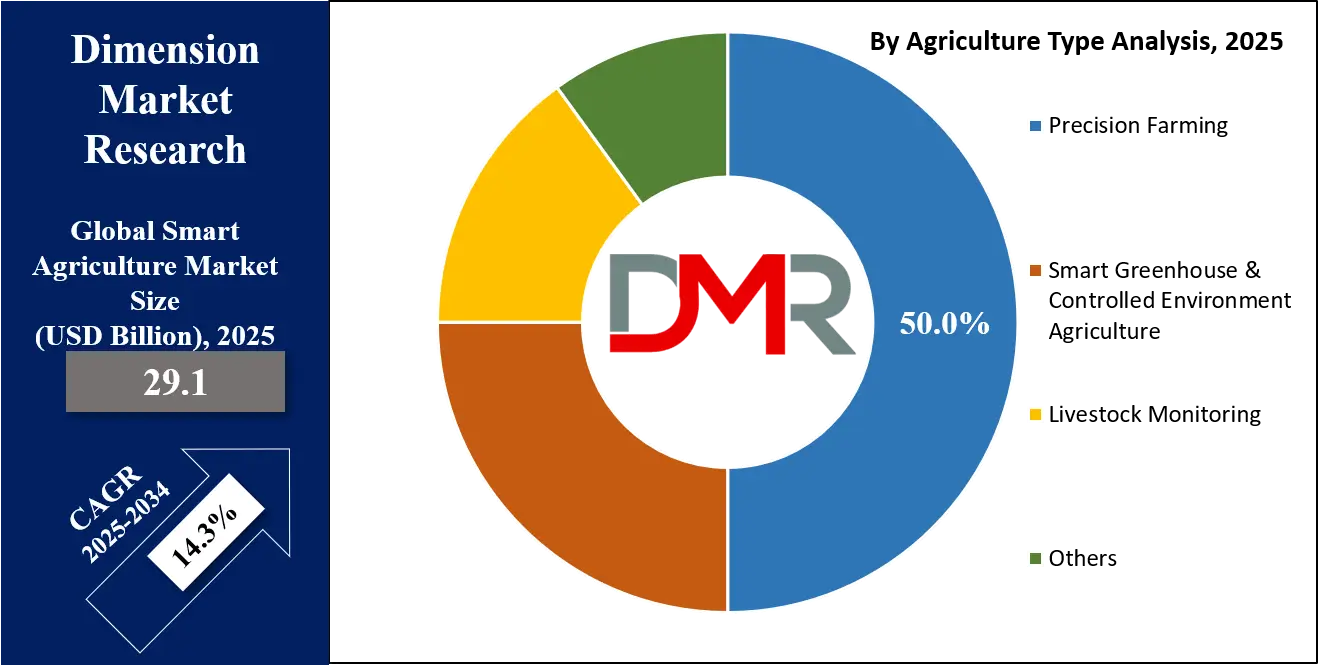
By Application Analysis
Yield monitoring and crop management is expected to lead the application segment, capturing 22.0% of the market share in 2025. This dominance is driven by the growing need for farmers to optimize productivity and improve operational efficiency through data-driven insights. Yield monitoring systems use sensors, GPS, and advanced analytics to track crop growth, detect nutrient deficiencies, and assess the impact of environmental factors on yields.
Crop management platforms enable precise decision-making regarding planting schedules, fertilizer application, pest control, and harvest timing, helping farmers maximize output while minimizing resource use. The growing emphasis on sustainable agriculture and the demand for higher-quality produce further reinforce the adoption of these solutions globally.
Irrigation management is another key application within the smart agriculture market, focused on optimizing water usage and improving crop health. Smart irrigation systems leverage soil moisture sensors, weather data, and automated controllers to deliver the right amount of water at the right time, reducing wastage and preventing over-irrigation. By integrating IoT and data analytics, these solutions enable precise scheduling and real-time monitoring of water resources, ensuring crops receive adequate hydration even in regions with water scarcity. The growing global focus on water conservation and climate-resilient farming is driving the adoption of advanced irrigation management tools across large-scale and smallholder farms alike.
The Smart Agriculture Market Report is segmented on the basis of the following:
By Offering
- Hardware
- Sensors & Control Devices
- Drones & UAVs
- GPS/GNSS Systems
- Automation & Control Systems
- Smart Irrigation Equipment
- Monitoring & Imaging Devices
- Software
- Farm Management Software (FMS)
- Data Analytics & AI Platforms
- Climate & Weather Forecasting Tools
- Livestock Management Systems
- Supply Chain & Inventory Management Solutions
- Services
- Integration & Deployment Services
- Consulting & Advisory Services
- Support & Maintenance Services
- Training & Education Services
By Agriculture Type
- Precision Farming
- Smart Greenhouse & Controlled Environment Agriculture
- Livestock Monitoring
- Others
By Application
- Yield Monitoring & Crop Management
- Irrigation Management
- Field Mapping
- Livestock Health & Feeding Solutions
- Smart Greenhouse Applications
- Others
Global Smart Agriculture Market: Regional Analysis
Region with the Largest Revenue Share
North America is expected to lead the global smart agriculture market, accounting for 40.0% of total revenue in 2025. The region’s dominance is driven by widespread adoption of advanced technologies such as precision farming, IoT-enabled sensors, AI-driven farm management systems, and autonomous equipment. Strong government support, well-established agribusiness infrastructure, and high investment in agricultural innovation further accelerate market growth. Additionally, North American farmers are increasingly focused on sustainability, resource optimization, and data-driven decision-making, making the region a key hub for the development and deployment of smart agriculture solutions.
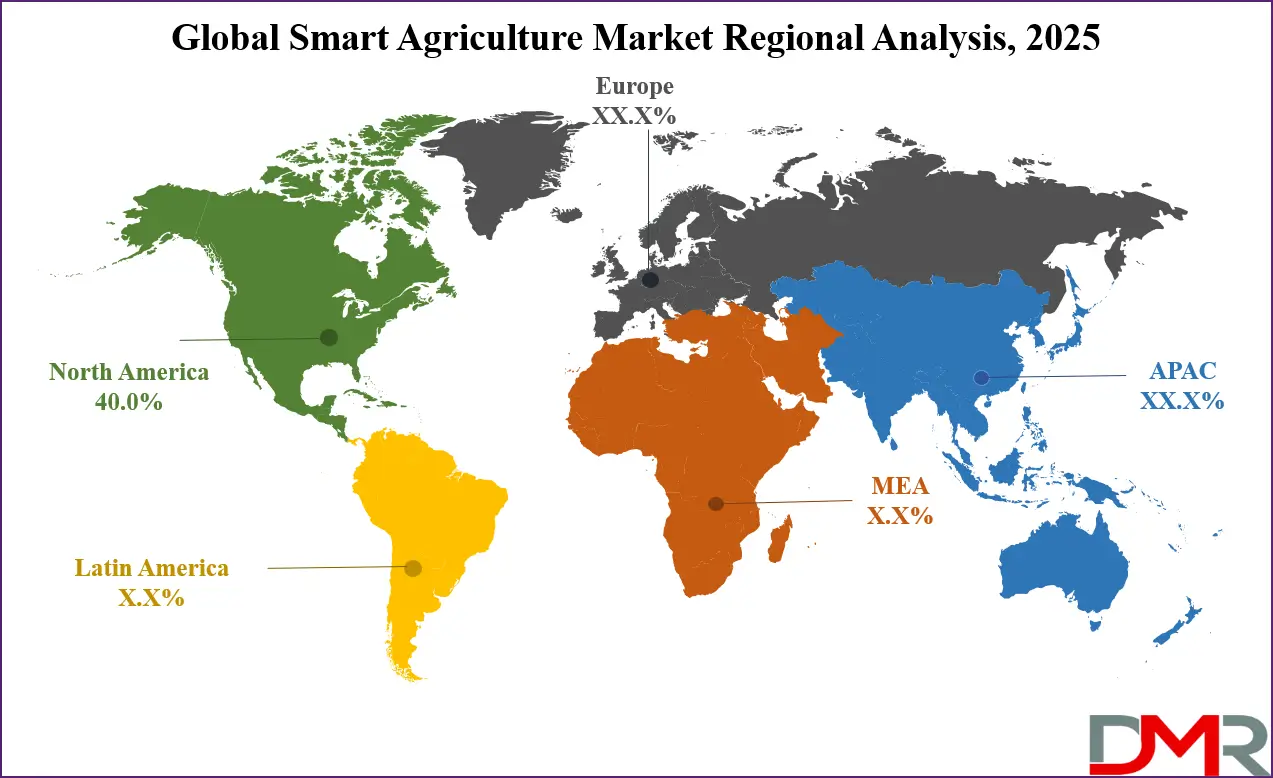
Region with significant growth
The Asia Pacific region is poised for significant growth in the global smart agriculture market due to growing adoption of precision farming technologies, rising investments in agri-tech startups, and government initiatives promoting digital and climate-resilient agriculture. Rapid population growth, expanding food demand, and limited arable land are driving farmers to implement IoT-enabled sensors, automated irrigation, and AI-powered farm management systems. Countries such as China, India, and Japan are witnessing accelerated deployment of smart greenhouse solutions and drone-assisted crop monitoring, positioning the region as one of the fastest-growing markets for smart agriculture solutions globally.
By Region
North America
Europe
- Germany
- The U.K.
- France
- Italy
- Russia
- Spain
- Benelux
- Nordic
- Rest of Europe
Asia-Pacific
- China
- Japan
- South Korea
- India
- ANZ
- ASEAN
- Rest of Asia-Pacific
Latin America
- Brazil
- Mexico
- Argentina
- Colombia
- Rest of Latin America
Middle East & Africa
- Saudi Arabia
- UAE
- South Africa
- Israel
- Egypt
- Rest of MEA
Global Smart Agriculture Market: Competitive Landscape
The global smart agriculture market is highly competitive, driven by the presence of established equipment manufacturers, technology providers, and innovative startups. Key players focus on strategic partnerships, product launches, and technological advancements to strengthen their market position. Companies are investing in precision farming tools, IoT-enabled sensors, AI-driven analytics platforms, and autonomous machinery to offer integrated solutions that enhance productivity and sustainability. Continuous innovation, mergers and acquisitions, and expansion into emerging markets are shaping the competitive dynamics, as players strive to meet the rising demand for data-driven, efficient, and environmentally sustainable agricultural practices globally.
Some of the prominent players in the global Smart Agriculture market are:
- Deere & Company (John Deere)
- AGCO Corporation
- CNH Industrial N.V.
- Trimble Inc.
- Topcon Positioning Systems
- Raven Industries
- AG Leader Technology
- Hexagon Agriculture
- Kubota Corporation
- Yara International
- DeLaval
- TeeJet Technologies
- BouMatic
- AKVA Group
- CropX Technologies
- Farmers Edge
- Climate LLC (Bayer Crop Science)
- AgJunction Inc.
- SemiosBio Technologies
- AeroVironment Inc.
- Other Key Players
Global Smart Agriculture Market: Recent Developments
- September 2025: AGCO Corporation unveiled the Fendt® 1000 Vario Gen4 tractor and the Optimum planter at the 2025 Farm Progress Show. The 1000 Vario Gen4 will be available for order in Q4 2025, with deliveries commencing in 2026. The Optimum planter is set to enter pre-sales in 2026.
- August 2025: John Deere announced the acquisition of GUSS Automation, a leader in autonomous orchard and vineyard sprayers. This acquisition expands John Deere's portfolio in high-value crop automation.
- July 2025: Bonsai Robotics acquired farm-ng, Inc., a startup specializing in modular electric robots. This merger aims to advance AI-driven agricultural autonomy.
- May 2025: The California state government allocated USD 200,000 to develop a new Regional Farm Equipment-Sharing Program. An additional USD 14 million is proposed for FY 2026-2027 to implement and expand the program.
Report Details
| Report Characteristics |
| Market Size (2025) |
USD 29.1 Bn |
| Forecast Value (2034) |
USD 97.2 Bn |
| CAGR (2025–2034) |
14.3% |
| The US Market Size (2025) |
USD 9.8 Bn |
| Historical Data |
2019 – 2024 |
| Forecast Data |
2026 – 2034 |
| Base Year |
2024 |
| Estimate Year |
2025 |
| Report Coverage |
Market Revenue Estimation, Market Dynamics, Competitive Landscape, Growth Factors, etc. |
| Segments Covered |
By Offering (Hardware, Software, Services), By Agriculture Type (Precision Farming, Smart Greenhouse & Controlled Environment Agriculture, Livestock Monitoring, Others), and By Application (Yield Monitoring & Crop Management, Irrigation Management, Field Mapping, Livestock Health & Feeding Solutions, Smart Greenhouse Applications, Others) |
| Regional Coverage |
North America – US, Canada; Europe – Germany, UK, France, Russia, Spain, Italy, Benelux, Nordic, Rest of Europe; Asia-Pacific – China, Japan, South Korea, India, ANZ, ASEAN, Rest of APAC; Latin America – Brazil, Mexico, Argentina, Colombia, Rest of Latin America; Middle East & Africa – Saudi Arabia, UAE, South Africa, Turkey, Egypt, Israel, Rest of MEA |
| Prominent Players |
Deere & Company (John Deere), AGCO Corporation, CNH Industrial N.V., Trimble Inc., Topcon Positioning Systems, Raven Industries, AG Leader Technology, Hexagon Agriculture, Kubota Corporation, Yara International, and Others. |
| Purchase Options |
We have three licenses to opt for: Single User License (Limited to 1 user), Multi-User License (Up to 5 Users), and Corporate Use License (Unlimited User) along with free report customization equivalent to 0 analyst working days, 3 analysts working days, and 5 analysts working days respectively. |